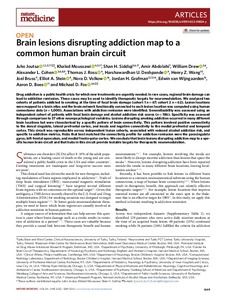Brain lesions disrupting addiction map to a common human brain circuit
Grafman Jordan H.; Bruss Joel; Joutsa Juho; Deshpande Harshawardhan U.; Volkow Nora D.; Boes Aaron D.; Moussawi Khaled; Ross Thomas J.; van Wijngaarden Edwin; Siddiqi Shan H.; Cohen Alexander L.; Drew William; Fox Michael D.; Abdolahi Amir; Stein Elliot A.; Wang Henry Z.
https://urn.fi/URN:NBN:fi-fe2022081155093
Tiivistelmä
Drug addiction is a public health crisis for which new treatments are urgently needed. In rare cases, regional brain damage can lead to addiction remission. These cases may be used to identify therapeutic targets for neuromodulation. We analyzed two cohorts of patients addicted to smoking at the time of focal brain damage (cohort 1 n = 67; cohort 2 n = 62). Lesion locations were mapped to a brain atlas and the brain network functionally connected to each lesion location was computed using human connectome data (n = 1,000). Associations with addiction remission were identified. Generalizability was assessed using an independent cohort of patients with focal brain damage and alcohol addiction risk scores (n = 186). Specificity was assessed through comparison to 37 other neuropsychological variables. Lesions disrupting smoking addiction occurred in many different brain locations but were characterized by a specific pattern of brain connectivity. This pattern involved positive connectivity to the dorsal cingulate, lateral prefrontal cortex, and insula and negative connectivity to the medial prefrontal and temporal cortex. This circuit was reproducible across independent lesion cohorts, associated with reduced alcohol addiction risk, and specific to addiction metrics. Hubs that best matched the connectivity profile for addiction remission were the paracingulate gyrus, left frontal operculum, and medial fronto-polar cortex. We conclude that brain lesions disrupting addiction map to a specific human brain circuit and that hubs in this circuit provide testable targets for therapeutic neuromodulation.Lesions resulting in addiction remission occur in multiple different brain locations but map to a specific brain circuit and that hubs in this circuit provide testable targets for therapeutic neuromodulation.
Kokoelmat
- Rinnakkaistallenteet [19207]
